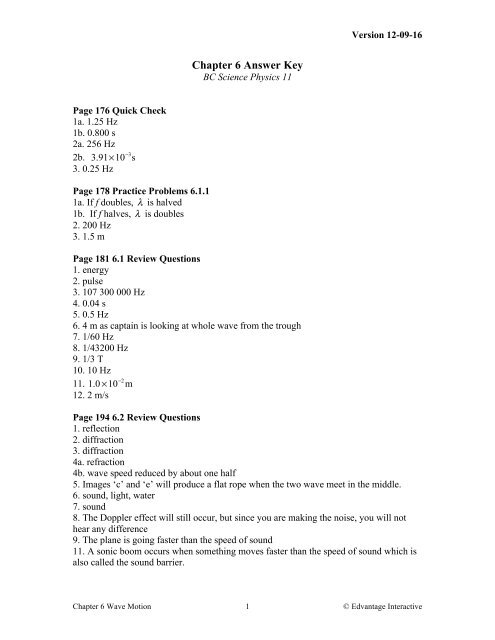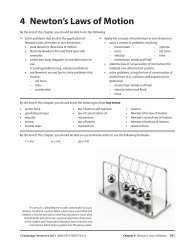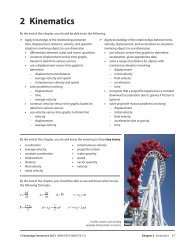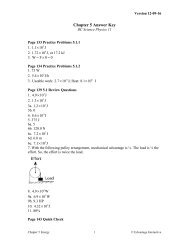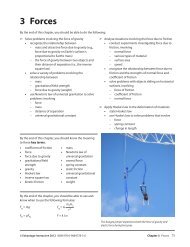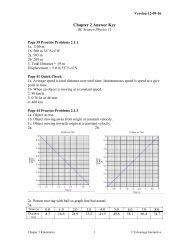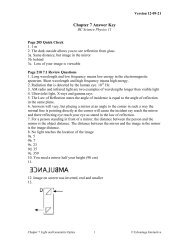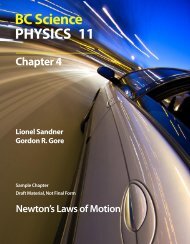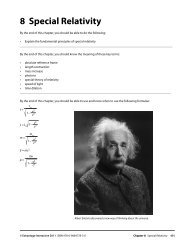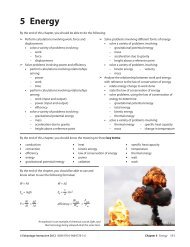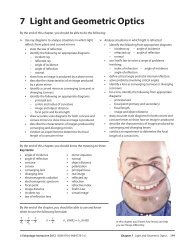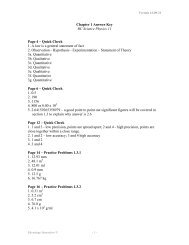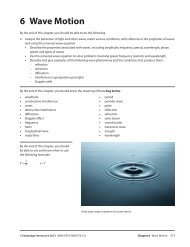Chapter 6 Answer Key - BC Science Physics 11
Chapter 6 Answer Key - BC Science Physics 11
Chapter 6 Answer Key - BC Science Physics 11
You also want an ePaper? Increase the reach of your titles
YUMPU automatically turns print PDFs into web optimized ePapers that Google loves.
Page 176 Quick Check<br />
1a. 1.25 Hz<br />
1b. 0.800 s<br />
2a. 256 Hz<br />
2b. 3.91×10 −3 s<br />
3. 0.25 Hz<br />
Page 178 Practice Problems 6.1.1<br />
1a. If f doubles, λ is halved<br />
1b. If f halves, λ is doubles<br />
2. 200 Hz<br />
3. 1.5 m<br />
<strong>Chapter</strong> 6 <strong>Answer</strong> <strong>Key</strong><br />
<strong>BC</strong> <strong>Science</strong> <strong>Physics</strong> <strong>11</strong><br />
Page 181 6.1 Review Questions<br />
1. energy<br />
2. pulse<br />
3. 107 300 000 Hz<br />
4. 0.04 s<br />
5. 0.5 Hz<br />
6. 4 m as captain is looking at whole wave from the trough<br />
7. 1/60 Hz<br />
8. 1/43200 Hz<br />
9. 1/3 T<br />
10. 10 Hz<br />
<strong>11</strong>. 1.0 ×10 −2 m<br />
12. 2 m/s<br />
Version 12-09-16<br />
Page 194 6.2 Review Questions<br />
1. reflection<br />
2. diffraction<br />
3. diffraction<br />
4a. refraction<br />
4b. wave speed reduced by about one half<br />
5. Images ‘c’ and ‘e’ will produce a flat rope when the two wave meet in the middle.<br />
6. sound, light, water<br />
7. sound<br />
8. The Doppler effect will still occur, but since you are making the noise, you will not<br />
hear any difference<br />
9. The plane is going faster than the speed of sound<br />
<strong>11</strong>. A sonic boom occurs when something moves faster than the speed of sound which is<br />
also called the sound barrier.<br />
<strong>Chapter</strong> 6 Wave Motion 1 © Edvantage Interactive
Version 12-09-16<br />
Page 196 <strong>Chapter</strong> 6 Review Questions<br />
1. A pulse in a non-repeating wave. A periodic wave is repeating waves<br />
2. See page 175 in work text<br />
3. Hertz is the measure of frequency and refers to how many times per second.<br />
4. Frequency and period are reciprocals of each other.<br />
5a. 2.5 Hz<br />
5b. 0.40 s<br />
6. Transverse waves are produced by a vibration or disturbance that is at right angles to<br />
the motion. Longitudinal waves travel in the direction of the pulse.<br />
7. Wave speed is the product of wave frequency and wavelength<br />
8. 5.0 ×10 6 m<br />
9. 0.645 m<br />
<strong>11</strong>. Refraction is the bending of a wave like when a water wave enters a shallower body<br />
of water. Diffraction is when a wave spreads out as it passes through narrow openings,<br />
around corners or small obstacles. For example, the rainbow you observe when you move<br />
a DVD disc in the light.<br />
12a. decrease<br />
12b. decrease<br />
12c. bend so they are more perpendicular to the surface<br />
13a. Constructive interference is when waves add together when they meet<br />
13b. Destructive interference is when wave cancel each other when they meet<br />
14. Nodal lines are destructive interference and maximum is constructive interference<br />
15. Circular waves, originating at the focus, reflect from the first mirror as straight,<br />
parallel waves that travel to the second mirror, reflect as circular waves with a center at<br />
the focus of the second mirror, where the match is.<br />
16. 4.5×10 3 m<br />
Page 198 <strong>Chapter</strong> 6 Extra Practice<br />
1.<br />
2a.<br />
2b.<br />
3.<br />
4.<br />
5a.<br />
5b.<br />
5c.<br />
6.<br />
7.<br />
8.<br />
9.<br />
10.<br />
<strong>11</strong>.<br />
12.<br />
<strong>Chapter</strong> 6 Wave Motion 2 © Edvantage Interactive
13a.<br />
13b.<br />
14.<br />
15.<br />
16.<br />
17.<br />
18a.<br />
18b.<br />
18c.<br />
Version 12-09-16<br />
<strong>Chapter</strong> 6 Wave Motion 3 © Edvantage Interactive


